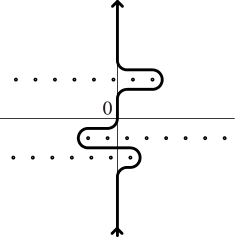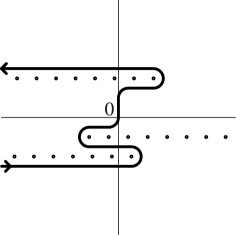§16.17 Definition
Again assume and are real or complex parameters. Assume also that and are integers such that and , and none of is a positive integer when and . Then the Meijer -function is defined via the Mellin–Barnes integral representation:
| 16.17.1 | |||
where the integration path separates the poles of the factors from those of the factors . There are three possible choices for , illustrated in Figure 16.17.1 in the case , :
-
(i)
goes from to . The integral converges if and .
-
(ii)
is a loop that starts at infinity on a line parallel to the positive real axis, encircles the poles of the once in the negative sense and returns to infinity on another line parallel to the positive real axis. The integral converges for all () if , and for if .
-
(iii)
is a loop that starts at infinity on a line parallel to the negative real axis, encircles the poles of the once in the positive sense and returns to infinity on another line parallel to the negative real axis. The integral converges for all if , and for if .
 |
 |
 |
| Case (i) | Case (ii) | Case (iii) |
When more than one of Cases (i), (ii), and (iii) is applicable the same value is obtained for the Meijer -function.
Assume , no two of the bottom parameters , , differ by an integer, and is not a positive integer when and . Then
| 16.17.2 | |||
where indicates that the entry is omitted. Also,
| 16.17.3 | |||
